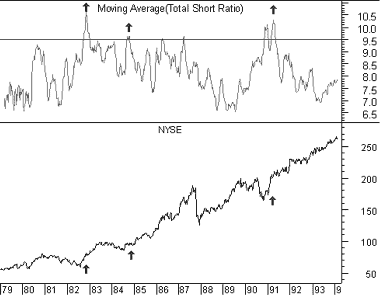
Technical Analysis from A to Z
by Steven B. Achelis
TOTAL SHORT RATIO
Overview
The Total Short Ratio ("TSR") shows the percentage of short sales to the total volume on the New York Stock Exchange.
Interpretation
As with the Public Short Ratio, the Total Short Ratio takes the contrarian view that short sellers are usually wrong. While the odd lotters are typically the worst of the short sellers, history has shown that even the specialists tend to over-short at market bottoms.
The TSR shows investor expectations. High values indicate bearish expectations and low values indicate bullish expectations. Taking a contrarian stance, when there are high levels of shorts (many investors expect a market decline), we would expect the market to rise. Likewise, extremely low levels of short sales should indicate excessive optimism and the increased likelihood of a market decline.
The interpretation of all of the short sale indicators has become more difficult recently due to option hedging and arbitrage. However, they are still helpful in determining overall market expectations.
Example
The following chart shows the New York Stock Exchange and a 10-week moving average of the Total Short Ratio.

I drew "buy" arrows each time investors were excessively bearish. In hindsight, each of these turned out to be excellent times to enter the market.
Calculation
The Total Short Ratio is calculated by dividing the total number of short sales by the total number of buy and sell orders. Both of these figures are reported weekly (on Fridays) by the NYSE.
![]()
Contents
- Preface
- Acknowledgments
- Terminology
- To Learn More
- Bibliography
- About the Author
- Technical Analysis
- Price Fields
- Charts
- Support & Resistance
- Trends
- Moving Averages
- Indicators
- Market Indicators
- Line Studies
- Periodicity
- The Time Element
- Conclusion
- Absolute Breadth Index
- Accumulation/Distribution
- Accumulation Swing Index
- Advance/Decline Line
- Advance/Decline Ratio
- Advancing-Declining Issues
- Advancing, Declining, Unchanged Volume
- Andrews' Pitchfork
- Arms Index
- Average True Range
- Bollinger Bands
- Breadth Thrust
- Bull/Bear Ratio
- Candlesticks - Japanese
- CANSLIM
- Chaikin Oscillator
- Commodity Channel Index
- Commodity Selection Index
- Correlation Analysis
- Cumulative Volume Index
- Cycles
- Demand Index
- Detrended Price Oscillator
- Directional Movement
- Dow Theory
- Ease of Movement
- Efficient Market Theory
- Elliott Wave Theory
- Envelopes (Trading Bands)
- Equivolume/Candlevolume
- Fibonacci Studies
- Four Percent Model
- Fourier Transform
- Fundamental Analysis
- Gann Angles
- Herrick Payoff Index
- Interest Rates
- Kagi
- Large Block Ratio
- Linear Regression Lines
- MACD
- Mass Index
- McClellan Oscillator
- McClellan Summation Index
- Median Price
- Member Short Ratio
- Momentum
- Money Flow Index
- Moving Averages
- Negative Volume Index
- New Highs-Lows Cumulative
- New Highs-New Lows
- New Highs/Lows Ratio
- Odd Lot Balance Index
- Odd Lot Purchases/Sales
- Odd Lot Short Ratio
- On Balance Volume
- Open Interest
- Open-10 TRIN
- Option Analysis
- Overbought/Oversold
- Parabolic SAR
- Patterns
- Percent Retracement
- Performance
- Point & Figure
- Positive Volume Index
- Price and Volume Trend
- Price Oscillator
- Price Rate-of-Change
- Public Short Ratio
- Puts/Calls Ratio
- Quadrant Lines
- Relative Strength, Comparative
- Relative Strength Index
- Renko
- Speed Resistance Lines
- Spreads
- Standard Deviation
- STIX
- Stochastic Oscillator
- Swing Index
- Three Line Break
- Time Series Forcast
- Tirone Levels
- Total Short Ratio
- Trade Volume Index
- Trendlines
- TRIX
- Typical Price
- Ultimate Oscillator
- Upside/Downside Ratio
- Upside/Downside Volume
- Vertical Horizonal Filter
- Volatility, Chaikin's
- Volume
- Volume Oscillator
- Volume Rate-of-Change
- Weighted Close
- Williams' Accumulation/Distribution
- Williams' %R
- Zig Zag